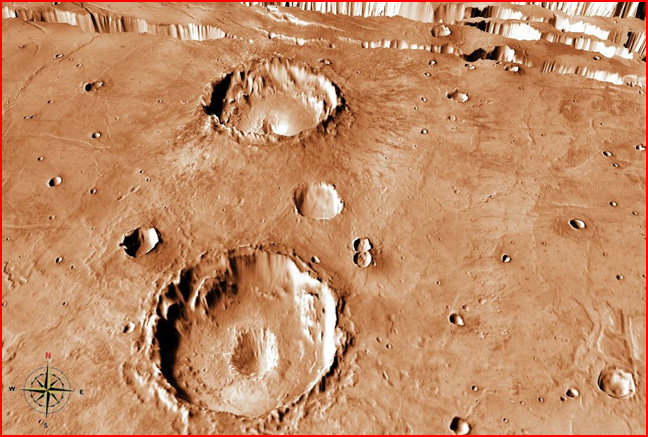
home •
about •
essential guide •
picture of the day •
thunderblogs •
news •
multimedia •
predictions •
products •
get involved •
contact
picture of the day archive subject index
This perspective view of two large craters south of Coprates Catena in Valles Marineris exaggerates depth in
order to give a clear impression of the “crater within a crater.” Credit: Photo courtesy of Michael Gmirkin and
NASA’s World Wind 3D visualization software.
Dec 13, 2006
Bull’s-Eye Craters
Impacts that “hit the bull’s eye” of a previous impact are “high-odds” improbable. But lightning—even planet-scale lightning—can strike twice in the same spot.One of the principal claims of the Electric Universe model is that many features on the surfaces of rocky bodies are scars left by electrical activity. A crater is produced when an electrical arc, consisting of two or more Birkeland currents rotating around a central axis, “sticks” to one location and “drills out” a circular depression.
Because electrical forces constrain an arc to strike a surface at a right angle, the crater will tend to be circular. Because the forces are distributed cylindrically, the crater will tend to have steep sides and a flat floor. Electrical forces lift debris from the surface, leaving no rim or a rim of “pinched-up” material. The properties of flat floor, steep edge, and removal of debris are why electrical etching has been developed into the industrial process of electrical discharge machining (EDM).
If the rotating currents do not touch at the central axis, they will leave a “peak” of undisturbed material. A sudden change in current or in current density, due to pinching forces in the arc or to the influx of charge-carrying debris, may cause the arc to “shrink” to a smaller diameter, leaving a terrace around the wall. Because the arc is maintained for an appreciable time by a continuous electrical current, melting of surface materials may be extensive.
In contradistinction, craters formed by mechanical impact tend to have rounded floors and rims. Because the forces are distributed spherically, debris is thrown out of the crater ballistically and deposited radially in a gradation of fineness and volume. The energy of the impact is dissipated in shock displacement of material: solids will “flow” as if liquefied and suddenly “freeze” when the impulsive force drops below a threshold. Very little melting occurs.
Careful inspection of rocky-body craters discloses their conformity with EDM.
The two craters in the above image are a variation on the EDM theme. They display the typical flat floors, steep sides, and pinched-up rims. They have terraces around their walls. But instead of central peaks, they have central craters. Two more craters that are similar lie to the southwest.
Our colleague Michael Mirkin, in pointing these craters out to us, has christened them “bull’s-eye craters,” in reference to the middle concentric circles of a dart board, emphasizing the difficulty of hitting the precise center consistently.
Under the impact interpretation, central craters could only be caused by a second impact that coincidentally struck exactly in the center of the previous impact. The impactors that created the craters would have to hit a perfect “bull’s eye” to create this effect. It might happen once. Twice in close proximity is extremely unlikely. But four times in the same neighborhood stretches the meaning of “coincidental” beyond the covers of the dictionary.
If the arcs that machined the large craters persisted until they pinched down into a very small diameter, or if a second return stroke followed the ionized path left by the first and persisted long enough, the central peaks (if they were not already machined away) would have been “drilled down,” perhaps even to a depth below the original craters’ floors. Such an event would not be the norm, but several “bull’s-eye craters” in a particular area would not be surprising. It may be significant that the four examples noted here lie on the plain just south of Valles Marineris, the largest EDM channel (from a traveling arc) in the Solar system.
See also:
Martian Butte and Crater, Layered Crater, Domed Craters on Mars
Contributed by Mel Acheson
___________________________________________________________________________Please visit our Forum
The Electric Sky and The Electric Universe available now!

|
|

|
EXECUTIVE EDITORS:
David Talbott, Wallace Thornhill
MANAGING EDITORS:
Steve Smith, Mel Acheson
CONTRIBUTING EDITORS: Dwardu Cardona, Ev Cochrane,
C.J. Ransom, Don Scott, Rens van der Sluijs, Ian Tresman
WEBMASTER: Brian Talbott
Copyright 2006: thunderbolts.info
![]()
home •
thunderblogs •
forum •
picture of the day •
resources •
team •
updates •
contact us

